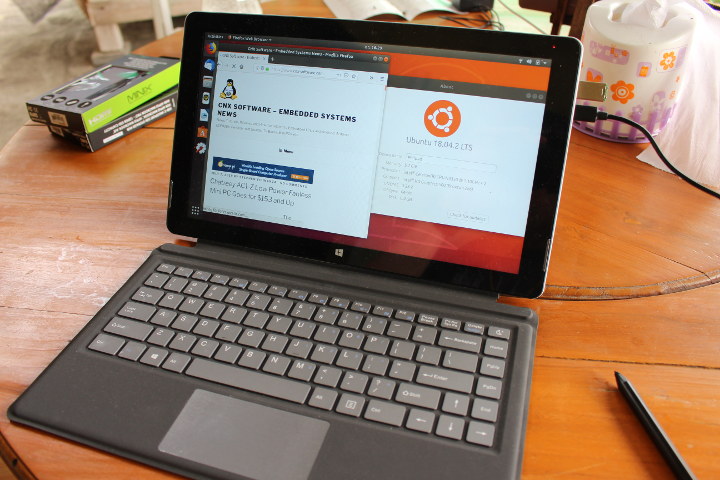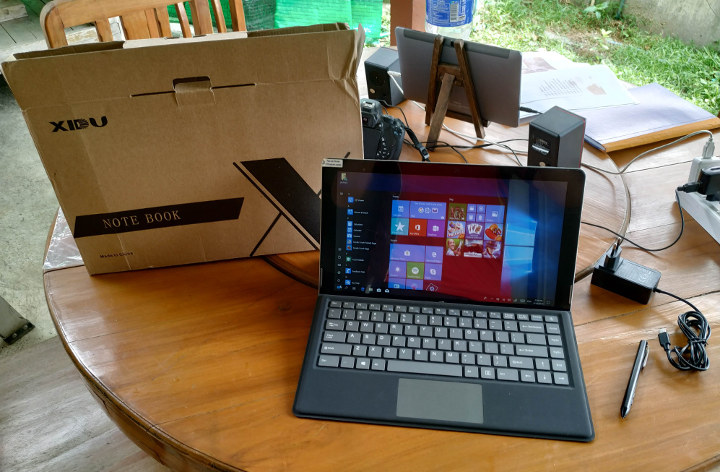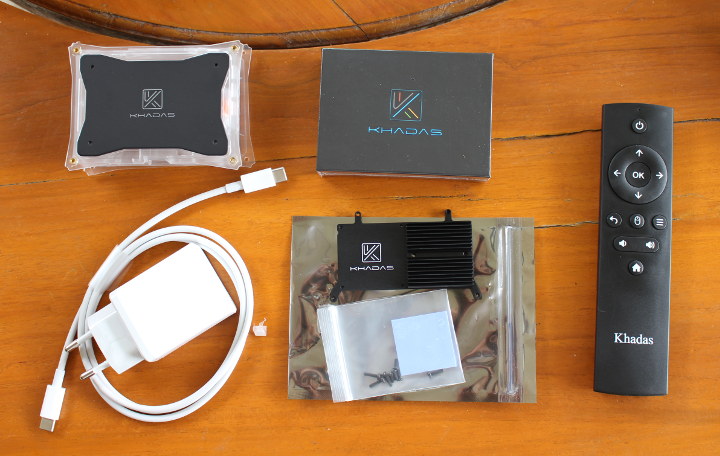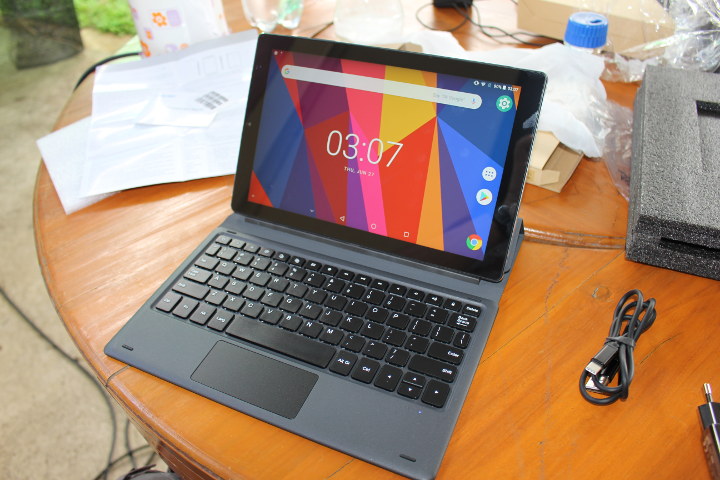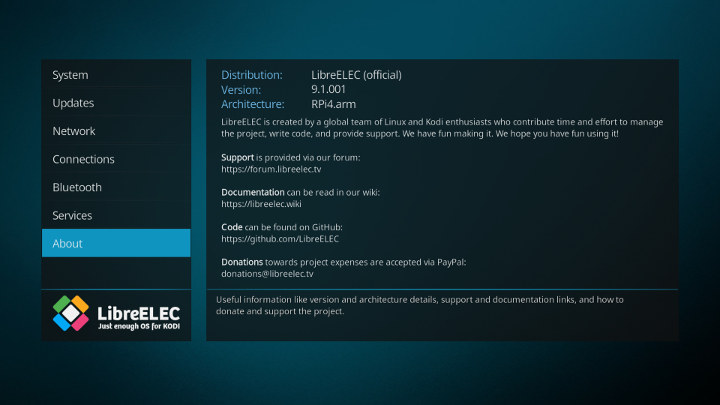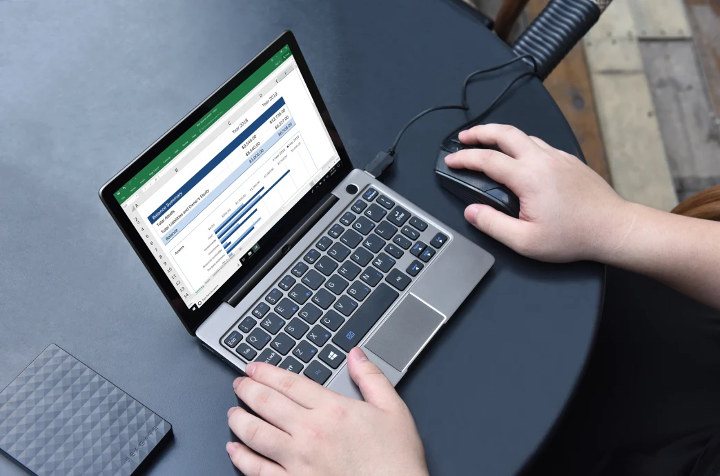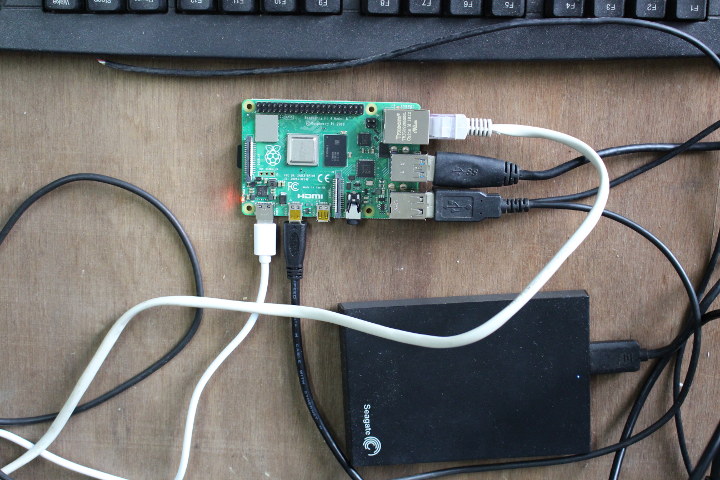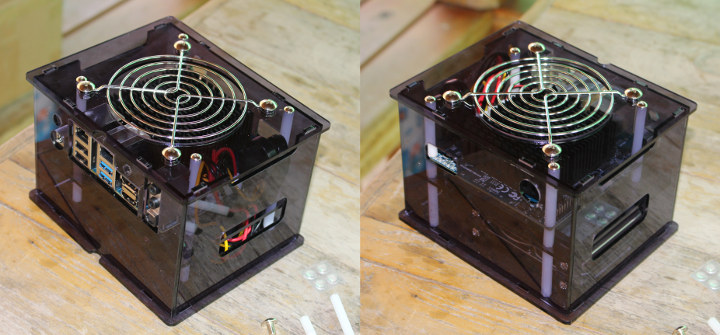So I’ve recently completed the review of XIDU Philpad 2-in-1 hybrid with Windows 10. The laptop features a 13.3″ touchscreen and support stylus, and I was intrigued whether those would work in Ubuntu 18.04. So I flash the Ubuntu 18.04.2 Desktop ISO to a flash drive and installed Ubuntu to another USB flash drive to give it a try with persistent storage. Note that while it’s OK for testing, running Ubuntu 18.04 from a USB flash drive is very slow, so it’s not recommended. The good news is that you can enter the BIOS by pressing either Esc or Del at boot time, an option is available to select Linux in the BIOS. I could then select Partition 1 in my bootable flash drive, and install Ubuntu 18.04 on the other drive with some patience, and everything works smoothly, albeit slowly due to using a cheap USB flash drive during […]
XIDU PhilPad 2-in-1 Hybrid 2K Laptop Review
I had never heard about XIDU laptops and tablets, and it’s apparently the brand name of “Shenzhen Baohuazhong Co Limited” that was founded in 2014 and specializes in the design, development, manufacturing, distributions, and support for computer systems. I came to know about the company as they approached me to review one of their laptops, namely XIDU PhilPad XT133A model with an Intel Celeron N3350 dual-core Apollo Lake processor coupled with 6GB RAM and 64GB storage, and equipped with a 13.3″ touchscreen display with 2K (2560×1440) resolution. XIDU PhilPad Specifications SoC – Intel Celeron N3350 dual core Apollo Lake processor @ 1.10 GHz / 2.40 GHz (Turbo) with 12EU Intel HD graphics 500 GPU; 6W TDP System Memory – 6GB DDR3 Storage – 64GB eMMC flash, microSD card slot Display – 13.3″ touchscreen IPS display with 2560 x 1440 resolution Audio – 3.5mm headphone jack, built-in microphone and speaker Camera […]
Khadas VIM3 Review – Part 1: Kit Unboxing and Assembly
We started to read about Khadas VIM3 in May of this year as an Amlogic S922X development board with an M.2 socket for NVMe SSD, and 802.11ac WiFi 5 & Bluetooth 5.0 wireless module. Eventually, Shenzhen Wesion decided to change the processor to Amlogic A311D before the launch last month, since it does not cost much more, but includes a 5.0 TOPS neural processing engine. The company has sent me a Khadas VIM3 kit for evaluation and review. Before going through the software part, and especially the tools for the NPU which will be one of the highlights of the board, I’ll check out what I received today, and show how to assemble the kit. Khadas VIM3 Kit Unboxing The package is rather boring… But what’s really important is what’s inside… We’ve got an enclosure, a smaller package with the board itself, a USB-C power supply, a thermal pad + […]
Chuwi HiPad LTE Tablet Review – Part1: Specs and Unboxing
Chuwi HiPad LTE is an 10.1″ tablet running Android 8.0 Oreo on a MediaTek Helio X27 deca-core processor coupled with 3GB RAM, 32GB flash, and offering both dual band WiFi and LTE connectivity. The company just sent me a sample, and today I’ll quickly go through the specifications, before unboxing the two packages I received. Specifications SoC – Mediatek Helio X27 (MT6797) deca-core processor with 2x Cortex-A72 cores @ 2.6 GHz, 4x Cortex A53 cores @ 2.0 GHz, and 4x Arm Cortex-A53 cores @ 1.6 GHz, as well as an Arm Mali-T880 GPU clocked at up to 875MHz System Memory – 3GB RAM Storage – 32GB eMMC flash, microSD card socket up to 128GB Display – 10.1″ IPS capacitive screen with 1920 x 1200 resolution Audio – 3.5mm headphone jack, built-in stereo speaker and microphone Camera – 5.0MP rear camera, 5.0MP front-facing camera Connectivity Dual band 802.11a/b/g/n/ac WiFi 5 Bluetooth […]
4K Video Playback on Raspberry Pi 4 with LibreELEC (Alpha)
In my short Raspberry Pi 4 review, I tested 4K video output and playback in Raspbian, and sadly neither are working properly, with video output stuck to 1080p60 even after selecting 4K HDMI in the settings and yes, I double checked for “hdmi_enable_4k=1” in config.txt, while H.265 video playback is still clearly using software decode in both VLC and omxplayer. However, LibreELEC team announced support for Raspberry Pi 4 in LibreELEC 9.2 Alpha1 release based on Kodi 18.3 and Linux 4.19.x. So I downloaded LibreELEC-RPi4.arm-9.1.001.img.gz and flash it to a microSD card with balenaEtcher. The good news is that I could manually set the resolution to 3840×2160 and confirm it works with my TV, but the refresh is limited to 30 Hz maximum. Other refresh rates currently available include 23.98 Hz, 24 Hz, 25 Hz, and 29.97 Hz. The hardware is capable if 4K 60Hz, so it’s just a question […]
GPD P2 Max 8.9″ Ultrabook Launched on Indiegogo for $530 and Up
The previously unveiled GPD Pocket 2 Max has now launched on Indiegogo under the name GPD P2 Max. The mini laptop, which the company refers to as an Ultrabook, is powered by an Intel Core m3-8100Y Amber Lake processor coupled with up to 16GB RAM and 512GB SSD storage and features an 8.9″ high-resolution touchscreen display. Beside the Amber Lake processor, the company is also offering a lower cost model with an Intel Celeron 3965Y Kaby Lake-Y processor going for $530 in Indiegogo, against the $705 asked for the Intel Core m3-8100Y Ultrabook. GPD P2 Max Ultrabook specifications: SoC (one or the other) Intel Celeron 3965Y dual-core Kaby Lake processor @ 1.50 GHz with Intel HD graphics 615; 6W TDP Intel Core m3-8100Y dual-core/quad-thread Amber Lake processor @ 1.1 / 3.4 (Turbo) GHz with 24EU Intel UHD Graphics 615; 5W TDP, but configured with TDP-up @ 8W System Memory & […]
Raspberry Pi 4 Benchmarks & Mini Review
Raspberry Pi 4 has just been released with many improvements over Raspberry Pi 3 Model B+ including a faster processor, a proper Gigabit Ethernet port, USB 3.0 interfaces, and 4K video support. That’s the theory, but how does it work in practice? I can now let you know as I’ve received a Raspberry Pi 4 sample courtesy of Cytron, and ran some tests and benchmarks on the very latest boards from the Raspberry Pi foundation. System Info Before starting with the benchmarks, let’s go through some basic system info:
|
1 2 3 4 5 6 7 8 9 10 11 12 13 14 15 16 17 18 19 20 21 22 23 24 25 26 27 28 29 30 31 32 33 34 35 36 37 38 39 40 41 42 43 44 45 |
pi@raspberrypi:~ $ cat /etc/issue Raspbian GNU/Linux 10 \n \l pi@raspberrypi:~ $ uname -a Linux raspberrypi 4.19.46-v7l+ #866 SMP Fri Jun 7 18:00:39 BST 2019 armv7l GNU/Linux pi@raspberrypi:~ $ df -h Filesystem Size Used Avail Use% Mounted on /dev/root 13G 4.7G 7.4G 39% / devtmpfs 334M 0 334M 0% /dev tmpfs 463M 0 463M 0% /dev/shm tmpfs 463M 6.4M 456M 2% /run tmpfs 5.0M 4.0K 5.0M 1% /run/lock tmpfs 463M 0 463M 0% /sys/fs/cgroup /dev/mmcblk0p6 253M 40M 213M 16% /boot tmpfs 93M 0 93M 0% /run/user/1000 /dev/sda4 200G 175G 24G 89% /media/pi/USB3_BTRFS /dev/sda2 241G 181G 48G 80% /media/pi/USB3_EXT4 /dev/sda1 245G 182G 63G 75% /media/pi/USB3_NTFS pi@raspberrypi:~ $ cat /proc/cpuinfo processor : 0 model name : ARMv7 Processor rev 3 (v7l) BogoMIPS : 270.00 Features : half thumb fastmult vfp edsp neon vfpv3 tls vfpv4 idiva idivt vfpd32 lpae evtstrm crc32 CPU implementer : 0x41 CPU architecture: 7 CPU variant : 0x0 CPU part : 0xd08 CPU revision : 3 .... processor : 3 model name : ARMv7 Processor rev 3 (v7l) BogoMIPS : 270.00 Features : half thumb fastmult vfp edsp neon vfpv3 tls vfpv4 idiva idivt vfpd32 lpae evtstrm crc32 CPU implementer : 0x41 CPU architecture: 7 CPU variant : 0x0 CPU part : 0xd08 CPU revision : 3 Hardware : BCM2835 Revision : a03111 Serial : 00000000ea51204b |
|
1 2 3 4 5 6 7 8 9 10 11 12 13 14 15 16 17 18 19 20 21 22 23 24 25 26 27 28 29 30 31 32 33 34 35 36 37 38 39 40 41 |
$ inxi -Fc0 System: Host: raspberrypi Kernel: 4.19.46-v7l+ armv7l bits: 32 Console: tty 1 Distro: Raspbian GNU/Linux 10 (buster) Machine: Type: ARM Device System: Raspberry Pi 4 Model B Rev 1.1 details: BCM2835 rev: a03111 serial: 00000000ea51204b CPU: Topology: Quad Core model: ARMv7 v7l variant: cortex-a72 bits: 32 type: MCP Speed: 1500 MHz min/max: 600/1500 MHz Core speeds (MHz): 1: 1500 2: 1500 3: 1500 4: 1500 Graphics: Device-1: bcm2835-vc4 driver: vc4_drm v: N/A Device-2: bcm2835-hdmi driver: N/A Display: tty server: X.org 1.20.4 driver: modesetting unloaded: fbdev tty: 80x24 Message: Advanced graphics data unavailable in console. Try -G --display Audio: Device-1: bcm2835-audio driver: bcm2835_audio Device-2: bcm2835-hdmi driver: N/A Sound Server: ALSA v: k4.19.46-v7l+ Network: Message: No ARM data found for this feature. IF-ID-1: eth0 state: up speed: 1000 Mbps duplex: full mac: dc:a6:32:00:9e:9c IF-ID-2: wlan0 state: up mac: dc:a6:32:00:9e:9d Drives: Local Storage: total: 946.35 GiB used: 540.58 GiB (57.1%) ID-1: /dev/mmcblk0 vendor: SanDisk model: SL16G size: 14.84 GiB ID-2: /dev/sda type: USB vendor: Seagate model: Expansion size: 931.51 GiB Partition: ID-1: / size: 12.68 GiB used: 4.71 GiB (37.1%) fs: ext4 dev: /dev/mmcblk0p7 ID-2: /boot size: 252.0 MiB used: 39.3 MiB (15.6%) fs: vfat dev: /dev/mmcblk0p6 Sensors: Message: No sensors data was found. Is sensors configured? Info: Processes: 179 Uptime: 4h 37m Memory: 1000.5 MiB used: 324.1 MiB (32.4%) gpu: 76.0 MiB Init: systemd runlevel: 5 Shell: bash inxi: 3.0.32 |
For reference, you’ll find Raspberry Pi 4 Linux boot log here. Phoronix benchmarks Let’s go ahead and install the latest version of Phoronix benchmarks:
|
1 2 3 |
sudo apt install php-cli php-gd php-xml php-zip wget http://phoronix-test-suite.com/releases/repo/pts.debian/files/phoronix-test-suite_8.8.1_all.deb sudo dpkg -i phoronix-test-suite_8.8.1_all.deb |
Now let’s run the test to compare the performance of Raspberry Pi 4 model B to some other Arm Linux boards including Raspberry Pi 3 Model B.
|
1 |
phoronix-test-suite benchmark 1709271-TY-1704029RI26 |
For reference, my office has an […]
ODROID-H2 Rev B Review – Part 1: Kit Unboxing and Assembly
ODROID-H2 was announced in October 2018 as the first x86 SBC from Hardkernel. The board features an Intel Celeron J4105 Gemini Lake processor, two SO-DIMM slots for memory, two SATA ports and M.2 NVMe slot for storage, two Gigabit Ethernet ports, a mix of USB 3.0 and 2.0 ports, as well as HDMI and DisplayPort video outputs. The board went for sale the following month for $111, and the first batch of 2,000 boards was sold within 24 hours. In normal cases, this should not be a big problem, and in a few weeks, the company should have been able to produce more boards to fulfill the demand. But Intel decided to prioritize higher-end processors, and Gemini Lake SoCs’ manufacturing was put on the back foot. That means Hardkernel had to wait over 6 months to get supply of the Celeron J4150 processors. In the meantime, the company slightly redesign […]


